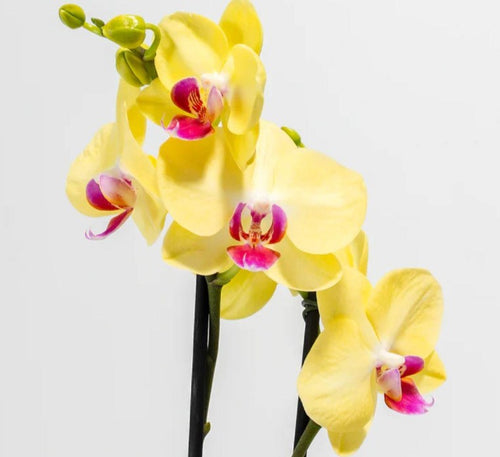Orchids Care Guide

-
Light : Medium
Phalaenopsis orchids prefer bright, indirect light. Place them near a window where they can receive plenty of indirect sunlight throughout the day. Direct sunlight can burn their leaves, so it's best to filter the light or provide shade during the hottest parts of the day.
-
Water : Medium
Water Phalaenopsis orchids when the potting medium is nearly dry. Typically, this means watering once every 7-10 days, but it can vary depending on factors like temperature, humidity, and potting medium. Ensure thorough watering, allowing excess water to drain out completely to prevent waterlogging.
-
Humidity : Medium
Phalaenopsis orchids prefer moderate to high humidity levels, ideally between 50-70%. You can increase humidity by placing a tray of water with pebbles beneath the orchid pot, using a humidifier, or grouping orchids together. Avoid placing them near drafts or heating/cooling vents, as these can dry out the air.
-
Temp : 60℉ - 85℉
Phalaenopsis orchids thrive in temperatures similar to those comfortable for humans. They prefer warmer temperatures during the day, around 75-85°F (24-29°C), and slightly cooler temperatures at night, around 60-65°F (16-18°C). Avoid exposing them to extreme temperature fluctuations.
-
Zone :
-
Fertilizer : Monthly
Your Phalaenopsis orchids will be extra happy if you fertilize every 2-4 weeks during the growing season (spring through early fall) with a balanced orchid fertilizer. Use a diluted fertilizer solution and apply it when watering to avoid over-fertilization, which can damage the roots. Reduce or stop fertilizing during the winter months when growth slows.
-
Repotting : 2 Years
Repot Phalaenopsis orchids every 1-2 years or when the potting medium breaks down and becomes soggy. Use a well-draining orchid mix and a pot that allows for good air circulation around the roots. Repotting is best done after flowering when new growth is beginning.
-
Cleaning : Monthly
Clean the leaves of Phalaenopsis orchids monthly to remove dust and debris. Use a soft, damp cloth or sponge to gently wipe the leaves, taking care not to damage them. This helps maintain proper leaf function and prevents pests from taking hold.
-
Propagation :